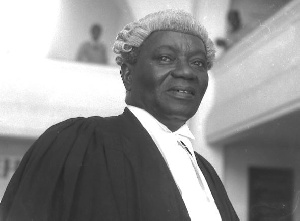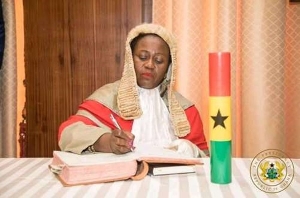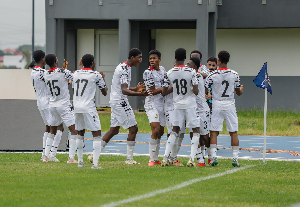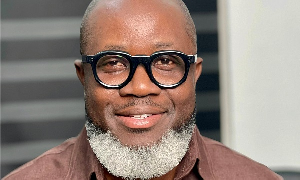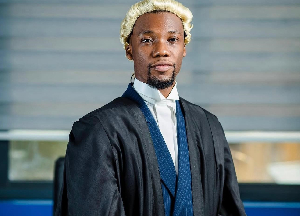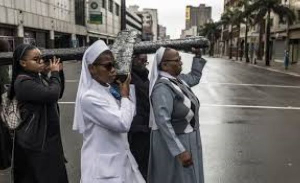Our answer to the question whether J. B. Danquah was the “chief campaigner” or “founder” of the University College of the Gold Coast, now University of Ghana, was that J. B. Danquah played a role but not a significant role; that the University of Ghana is a national university built by all the people, and therefore, ought to stay as such, as “The University of Ghana”.
By this paper, we are providing further, definitive, conclusion to the question about the role of J. B. Danquah in the founding of the University College of the Gold Coast, with respect to other contemporaries. The 3-part joint-paper (reader can get a copy using link below) exposed the shamelessly over-rated, over-hyped role of J. B. Danquah with respect to the subject, on its own merit.
Fact is, part-time Akyem Abuakwa solicitor and private legal practitioner, who, during the crucial years of the founding was busily defending 8 people arrested in 1944 for their role in the disappearance and murder of the Odikro of Apedwa soon after the death of Sir Ofori Atta I, would have had little time to found the University College of the Gold Coast (UCGC) in 1947, compared to other figures and contemporaries. Historical records show that the arrest, trial, and conviction of the 8 men, and execution of 7 of them, actually lasted through the end of 1947, and would have taken a great deal of Danquah’s time even though “a London solicitor named A.L. Bryden”, was flown in to assist the defense and the Akyem Abuakwa state in the long drawn-out criminal case. Those capital murder cases, ultimately, and tragically, failed for 7 of the accused.
As the UCGC was being founded, Danquah was just losing the biggest case he ever handled in his life as a lawyer.
According to one account:
“….His extraordinary energy in pressing the defence case to the farthest ends of legality obviously owed a great deal to his genuine personal conviction that family and state honour needed to be defended at all costs. But it is likely that there was personal expiation involved as well. The case certainly gave him prominence but it was not,….to advance his career...". (Rathbone).
Key aspects of the planning, resourcing, and development of the UCGC occurred during 1946 and 1947.
As Abgodeka (1998) suggests, J. B. Danquah had some, but not a significant role in the founding of UCGC. And so, if we must double-down using the lessons of objective history, as important as funds from cocoa farmers were to the project, the most accurate and relevant theme about the founding of UCGC is that the Government of the Gold Coast was the primary funder during establishment of the University College of the Gold Coast, (Lungu, Botwe-Asamoah, and Dompere, 2019).
Further, compared to speaking on radio and being a recognized leader in a legislature as one of Danquah’s contemporaries did/was, standing on a street corner and talking to people one assumes to be “farmers” and seconding motions in a legislative council did not a chief campaigner or founder of the UCGC, make.
As a national institution, we noted previously that Dr. Kwame Nkrumah’s “…internal self-government deserves great credit for the founding of the UCGC”.
It is the entity that followed through on the agreement reached between Creech Jones, the Secretary of State for the Colonies, and the Asantehene with respect to the establishment (and funding) of the Kumasi College of Technology in 1952, following the founding of the UCGC at Legon, earlier in 1947.
Significantly,
“…When the Gold Coast decided to have a university college, they were thinking of government financing it. It so happened that the Cocoa Marketing Board (CMB), the richest agency in the country, came to supplement government grants,…. (F)our main sources of funding for the UCGC were agreed upon. The first was the government grant which was to be given quinquennially i.e. from 1948-53,1953-1958…(on a 5-Year schedule). For the second quinquennium 1953-58 the emerging African government led by Dr. Kwame Nkrumah caused the amount to be doubled to £4 million,' so as to speed up the training of graduates for the government's Africanization programme. The year 1954 also saw the establishment of the second source of finance, an Endowment Fund, into which the Government (under Kwame Nkrumah) paid £2million…The CMB was the other source of finance for the UCGC…Lastly the undergraduates paid fees out of their government bursaries and this formed a source of funding for the College. The fees were for tuition, board and lodging. For the 1949-50 session, they were £63 for Intermediate Courses and £90 for Degree Courses…” (Agbodeka).
NOTE: Those government monies were from reserves. However, they were not “reserves” accrued by the Colonial Office operating out of London.
This definitive paper is for the benefit of all objective and impartial Ghanaians whose personal and familial interests and connections to Ghana, even if they had one or more, have not blinded them to seek unfair and indefensible national accolades, awards, and demands for naming and re-naming institutions after their fathers, grandfathers, and uncles. Records show many of those same “fathers, grandfathers, and uncles” were privileged, under-performers who had little regard for women and people from other parts of Ghana, and even for their own peoples. Historical records, some, newly-declassified, show that some of those men turned out to be traitors to their compatriots and Ghana, the evolving new nation. J. B. Danquah and Dr. Kofi Abrefa Busia were such.
We identify and publish today the names of 7 individuals whose efforts, just 5 years prior to independence, were most responsible for the “founding” of the UCGC now known as The University of Ghana during the most critical period, 1946-1952.

J. B. DANQUAH IN HIS OWN WORDS
Remarkably, in the “Souvenir Pamphlet…published to commemorate the third anniversary of the death of Doctor Joseph Boakye Danquah,” Danquah is quoted extensively with respect to certain of the notable figures we identify today, some of whom were mentioned in our 3-part paper. There is no mention of UCGC. For all intents and purposes, these are important new findings of our research.
Within the pages of the Danquah “Souvenir Pamphlet”, Danquah demonstrates his general attitude to politics under “Natural and anointed Rulers”. More important for our purpose, Danquah demonstrates his unqualified attention to certain matters and recognizes the superior work of several individuals who by his own definition could be called “masters”, in the professional sense.
READ:
“….In June 1946 J.B. was elected third Provincial Member of the Legislative Council under the Burns Constitution which gave to the Gold Coast an African-dominated Legislative Council…Before the election, Dr Danquah addressed a letter to Nananom of the Joint Council. This read as follows:
"Nananom,…you are assembled at Dodowah this week to select nine suitable Chiefs and non-Chiefs as Provincial Members of the Legislative Council. I am, as you are aware, one of the 19 candidates nominated for the five seats in the Eastern Province. I allowed my name to go forward for nomination not out of any presumption of my worthiness but chiefly because I have the greatest honour to consider myself a lifelong servant of our Natural and anointed Rulers….'My apprenticeship in public service at the feet of our Natural Rulers commenced in 1916 and, but for a short break of six years spent in England to enlarge my knowledge and experience, this apprenticeship bas been continuous, consistent and constant....'Throughout these 30 years I worked with E. J. P. Brown and towards the closing years of his life I gathered my clothes at the feet of Casely Hayford. His successors in the Legislative Council, Dr F. V. Nanka-Bruce and Mr Justice Korsah, as also those of the present decade, Mr G. E. Moore, Mr R. S. Blay, Mr Techie-Menson, and Mr Akilagpa Sawyerr, have at all times found me a willing assistant, when called upon….” (emphasis ours) (Funeral Souvenir, 1968).
Fair, objective, and historically-bounded analyses instruct us that “Kantian Philosopher” Dr. J. B. Danquah was never the chief campaigner for the University College of the Gold Coast, let alone its founder, compared to the 7 figures we highlight in this final paper.
We must further note that the “Funeral Souvenir” claims that J. B. Danquah was “…elected third Provincial Member of the Legislative Council...”. J. B. But, Danquah himself says he was “nominated”, which is far from being elected by the popular will of certain of his own people in Akyem Abuakwa, in the “Eastern Province”. (In passing, we will note that this is just one of several fabrications many Danquah supporters from Akyem Abuakwa have long attempted to sell to unsuspecting Ghanaians).
A SHORT NOTE ON SOURCES ON THE FOUNDING OF THE UCGC
For objective historical researchers and persons with no other direct interest in the matter of who were key figures in the founding of the UCGC, the Bourret “survey” is very significant. That account is practically a contemporaneous account of events as they were occurring in the Gold Coast up to 1948. Bourret in fact states thus:
“….While this new institution is gradually getting under way, there is urgent need for highly trained African men and women to carry out the Dependency’s development plans...” (Bourret, 1948).
Significantly, while Bourret cites a couple of manuscripts written by Danquah and provides a paragraph on the Gold Coast Youth Conference, Bourret does not associate the establishment of the new UCGC with J. B. Danquah. But, Bourret associates the UCGC with Sir Arku Korsah and Dr. Frederick V. Nanka-Bruce. (Bourret identifies sources cited in the “Preface” to the manuscript. We believe that for whatever reason, nearly 50 years later, many of those sources escaped Agbodeka because Agbodeka (1998) does not cite Bourret. And there are a few other key documents we are now reviewing that were also not cited by Agbodeka in that University of Ghana-commissioned book.
SEVEN (7) KEY FIGURES MOST RESPONSIBLE FOR THE FOUNDING OF THE UNIVERSITY COLLEGE OF THE GOLD COAST (UCGC)
As we looked further into the matter, our review of the history of the founding of the UCGC identified seven (7) key figures most responsible for that founding. They are individuals who were key members of official commissions; directly assisted by leading the enactment of laws, regulations, and procedures to support the UCGC; and provided or otherwise ensured financial resources were made available, and effectively and accountably utilized to support the UCGC during the critical years, 1946–1952.
The “Notable 7” are, in loose alphabetical order:
(1) Asantehene Otumfuor Agyemang Prempeh II
(2) David Mowbray Balme, Principal
(3) Dr. Frederick V. Nanka Bruce
(4) Dr. Kwame Nkrumah
(5) Reverend Professor C. G. Baeta
(6) Sir Arku Korsah
(7) Sir Edward O. Asafu-Adjaye
1. ASANTEHENE OTUMFUOR AGYEMANG PREMPEH II
When the Bradley Committee determined, based on vocal local support, that the People of the Gold Coast should have their own university college, the committee pressed to make sure "financial resources could be found locally", that the Asantehene, Otumfuor Agyemang Prempeh II, was on-board. The support of Asantehene for UCGC (Legon) was crucial - it allowed cocoa farmers to appreciate the importance of the mission. That support was forthcoming and made contingent to the establishment of a second university in the then Gold Coast, in Kumasi, as advanced by the Bradley Committee. (J. B. Danquah was never a member of the Bradley Committee. Further, at that time, a substantial amount of the cocoa revenue came from farmers in Regions other than Akyem where the swollen shoot disease was continuing to wreak havoc for farmers, who now were instructed to cut down their cocoa trees to control the contagion, and avoid infestation of other cocoa producing areas.
2. DAVID MOWBRAY BALME, ESQ
Agbodeka identified David Morbray Balme, Principle, as one of a few people who “worked hard to make the College’s financial administration smooth-going”. Expatriate Principal Balme had numerous meetings with officials of the Gold Coast Government, key among them “…Hon. K. A. Gbedemah who, as Minister of Finance and the Government’s representative on the College Council, communicated the cabinet decisions to the University College,” (Agbodeka).
As head of Academic Staff and life of the institution, it was Principal Balme who, early in 1948, when he was at “a meeting of the Special Committee of the Senate on Higher Education in the Colonies,” suggested a number of departments he wanted to start with at the UCGC. As head of Academic Staff, Principal Balme was a member of the Gold Coast University Council when it first met in 1949. Principal D. M. Balme Esq was a member of the the first “University Council”, and sat on the Council from 1948 to 1957. (The main library at Legon was named after D. M. Balme).
3. DR. FREDERICK V. NANKA BRUCE
Dr. Frederick V. Nanka Bruce was physician, journalist and politician. As a young man, he was part of Gov. Hodgson’s ill-fated attempt to capture the Golden Stool in 1900. He was captured by the Asantes and was later released. He earned his B.Sc. in Medicine & Surgery at Edinburgh University in 1906, worked in hospitals in London, and was the 3rd person to establish a medical practice in the Gold Coast. In 1902, he and 6 others signed a memo protesting Colonial Office policy barring anyone not of “European parentage” from establishing private medical practice in the colonies. In 1907, Dr. Nanka Bruce lodged another protest against racist policies in Gold Coast recruiting practices. Like E. O. Asafu-Adjaye, Ofori Atta, J. B. Danquah, Arku Korsah, Akilagpa Sawyer, James Mercer, and I. K. Agyeman, he was a member of committee that went to England to protest the Waterworks Bill, in 1934.
Dr. Nanka Bruce re-founded “The Gold Coast Independent” newspaper in 1918 which long campaigned for independence, and founded the “Echo” newspaper. In 1933, he co-founded Gold Coast Medical Practitioners Union, becoming the 1st President of the British Medical Association, in Ghana.
From Bourret’s account, Dr. Nanka Bruce, a leading member of Governor Burn’s Committee, and spokesperson of the committee, outlined the general findings of the committee in that Radio Voy speech in October of 1947 supporting the Elliot Commission’s “Majority Report”. As we’ve noted more than once, the event constituted a major inflexion point for demand by the Gold Coast for their own University College, and served as a rallying call to action by the Gold Coast public and colonial authorities.
Repeating, it was Dr. Nanka Bruce who rallied Gold Coasters on air:
“….the Gold Coast should eventually have its own university college on a site separate from Achimota, which would remain a secondary school, to elaborate…Owing to construction difficulties, however, it would be necessary to use the Achimota buildings until new ones would be available… (Plans should be pragmatic)…to provide trained African men and women to carry out the big task of development which lie ahead of the country”, (Bourret).
The Nanka Bruce radio address was largely instrumental in influencing the Secretary of State for the Colonies finally to give his consent early in 1947, for the establishment of a Gold Coast university college (Bourret).
In reference to Dr. J. B. Danquah, one cannot simply stand on lonely street corners, shout to people reputed to be “cocoa farmers”, and establish a university merely by virtue of one’s oratorical prowess, however formidable.
According to the literature, Dr. F. V. Nanka Bruce established several medical clinics in the Gold Coast. In fact, recently, we’ve had what we consider a once in a lifetime opportunity of speaking with one of his patients, Bismark C. Kpobie, Attorney, Supreme Court, Rtrd., who at that time was a little boy growing up in Accra.
As far as we can tell, one public facility, the “Dr. F. V. Nanka Bruce Junior High School,” in Mamprobi, Accra, bears his name. It was Mr. Kpobie who provided us that image of Dr. Nanka Bruce, from the Daily Graphic.
4. DR. KWAME NKRUMAH
Recalling Agbodeka yet again, the people:
“…who worked hard to make the College’s financial administration smooth-going included…the Prime Minister, Dr. Kwame Nkrumah,…(and Hon. K. A. Gbedemah who, as Minister of Finance and the Government’s representative on the College Council, communicated the cabinet decisions to the University College,….”, (1998).
The fact is, it was policies supported and approved by Kwame Nkrumah, including the guarantee and provision of government funds during the campaign for the implementation of the Majority Report and its attendant arrangements, that saw the establishment of the UCGC during 1947-1952. (When Finance Minister Gbedemah signed an agreement, it was certainly with the support and approval of Kwame Nkrumah).
To the point, Dr. Kwame Nkrumah’s internal self-government deserves great credit because it was the system, so to speak, that executed the agreement between the Secretary of State for the Colonies, Creech Jones, and the Asantehene with respect to the establishment of the Kumasi College of Technology in 1952, following the establishment of the UCGC, at Legon, in 1947/1948:
“…(In 1949)… four main sources of funding for the UCGC were agreed upon. The first was the government grant which was to be given quinquennially i.e. from 1948-53,1953-1958…(on a 5-Year schedule). For the second quinquennium 1953-58 the emerging African government led by Dr. Kwame Nkrumah caused the amount to be doubled to £4 million,' so as to speed up the training of graduates for the government's Africanization programme. The year 1954 also saw the establishment of the second source of finance, an Endowment Fund, into which the Government paid £2million…The CMB was the other source of finance for the UCGC (Agbodeka).
We know Kumasi College of Technology today as Kwame Nkrumah University of Science and Technology (KNUST).
5. REVEREND PROFESSOR C. G. BAETA
Reverend Professor C. G. Baeta, a member of the Gold Coast Legislative Council, who, from some accounts carried his Christian faith on his forehead, played an equally prominent role in raising monies for the university by traveling on his own to meet with the Asantehene and cocoa famers in the Ashanti province. As Agbodeka says, Professor Baeta appealed to the Asantehene and cocoa farmers to make financial contributions (through the CMB) towards the establishment of the UCGC with proceeds from cocoa sales, to the point:
“…Two members of the Legislative Council - Dr J. B. Danquah and Prof. Christian Baeta on their own volition worked on the question of securing funds for the project…”, (Abgodeka).
And so, our question to Mr. Paul Adom-Otchere still remains unanswered:
“….(I)f “two members of the legislative council, Dr. Danquah and Prof Baeta, on their own volition worked on this question of securing funds for the project” from farmers in the Ashanti Region, how come Paul Adom-Otchere discriminates against “Prof Baeta” and credits all the funds raised, all “897, 000 pounds sterling”, as “raised through Danquah’s effort” alone?
Actually, Rev. Professor Baeta was appointed and in fact served as faculty member of the new UCGC beginning in 1950. On the other hand, J. B. Danquah, on at least 2 occasions declined to serve at the Prince of Wales’ College (now Achimota College), where, in all important respects, the UCGC started from.
Professor Baeta became a pioneer, the first person ever appointed as “Professor Emeritus” of The University of Ghana.
6. Sir Arku Korsah
Sir Arku Korsah was the sole Gold Coaster on the Elliot Commission, which, which, as we’ve noted, also included 2 other West Africans (E. H. Taylor-Cummings of Sierra Leone and I. O. Ransome-Kuti of Nigeria). In October of 1945, the Gold Coast Central Committee on Education formally begun reviewing the Majority and Minority Reports of the Elliot Commission. Its members overwhelmingly supported the Majority recommendation championed by Sir Arku Korsah and West-African delegation.
We will note here, again, that the “Majority Report” championed by Sir Arku Korsah and the other 2 West Africans, recommended three university colleges:
(1) Nigeria - for the faculties of Arts, Science and Professional schools of medicine, agriculture, forestry, animal health and teacher education.
(2) Gold Coast - for faculties of arts, sciences and an institute of education
(3) Sierra-Leone - for courses in arts and Science up to the intermediate level and teacher training courses.
The next month (November, of 1945), the Gold Coast Central Committee on Education issued a statement protesting that: “Irreparable harm would be done by denying work began at Achimota…… ..which is ready to take off and which is urgently necessary to it and to the Gold Coast…”.
Sir K. A. Korsah was the Chairman and member of the Gold Coast University Council when it first met in 1949, through 1951 and 1957, then 1958- 1960, serving with Principal D. M. Balme, and Mr. Victor Owusu (the latter from the Ashanti Confederacy), during his long tenure and association with the UCGC/Legon.
We must note that Sir Arku Korsah signed the “Manifesto for Presentation to the United Nations Conference, San Francisco, April 1945”, on behalf of West African Students Union (WASU) with J. S. Annan of the Gold Coast Trade Unions, in addition to 9 other figures including George Padmore and T. A. Bankole.
7. SIR EDWARD O. ASAFU-ADJAYE
Sir Asafu-Adjaye was a member of the University College Council right at its first meeting, on 8 February, 1949 (Agbodeka).
Significantly, in 1946, Sir Asafu-Adjaye was the representative of the University College Council from the Ashanti Confederacy on the Legislative Council. This was during the time Dr. J.B. Danquah and Rev. Prof. Beata traveled to Asanteman to appeal to the Asantehene and cocoa farmers to make financial contributions towards the establishment of the UCGC with proceeds from cocoa sales, as reported by Agbodeka.
By any objective measure, we must recognize that the Asantehene and Ashanti cocoa farmers would listen more to their own representative in the legislative council. Surely, they would listen a lot more to Sir Asafu-Adjaye than to J. B. Danquah who never lived in Ashanti, or even in Akyem after he returned from his studies in the United Kingdom, for that matter.
CONCLUSION
As we’ve observed more than once, J. B. Danquah played a key role in the trial of eight (8) men, “all descendants of previous kings of Akyem Abuakwa” who were arrested in 1944 and charged with the disappearance and murder of the Odikro of Apedwa. The arrest, trial, and execution of 7 of the men, lasted all through 1944 – 1947. For all practical purposes, the foundation stones for major UCGC facilities were laid in 1947. For all the boastful and over-hyped statements in the J. B. Danquah “Funeral Souvenir”, and there are several, that document does not mention the UCGC/University of Ghana.
On that point, we will offer that by modern standards of courtroom procedures and truthfulness of lawyers as officers of courts, J. B. Danquah would probably have been thrown out of the courtroom and barred from practicing law for (1) offering entirely 2 contradictory reasons for the disappearance and death of the Odikro of Apedwa and (2) sending a letter to the Editor of the Daily Graphic protesting he did not “recall” using “nincompoop” to describe certain government officials. On the later, there were apparently a couple of 100 people, and more, who could have testified to the contrary. (We will explore this aspect of J. B. Danquah’s character in a forth-coming paper).
It should be clear to all that in death, aristocratic J. B. Danquah’s boastfulness and over-hyped sense of accomplishments, have been, and continue to be, promoted by his sons, grandsons, nephews, etc. In the end, every one of the “Notable 7” figures we’ve highlighted in this final paper did a lot more, they invested more of their lives and their own resources to help the Gold Coast “found” the University College of the Gold Coast, compared to Dr. J. B. Danquah.
Sir Arku Korsah could easily lead the pack of the most important figures responsible for the founding of the UCGC. But, Sir Arku Korsah was also a lawyer and jurist whose work in that area, from all available records, even dwarfs his work with the founding of the UCGC.
J. B. Danquah, if was alive and honest with himself, would most likely agree, today.
Dr. J. B. Danquah had no hand in the reports of the Elliot Commission, which Sir Arku Korsah did. Dr. J. B. Danquah was never a member of the Gold Coast Central Committee on Education, and surely was not serving at Achimota in any capacity when the idea about the UCGC actually was “….ready to take off….(from)…Achimota…”. J. B. Danquah could have, but he declined to serve in any official administrative or educational capacity on behalf of all the people at the then Gold Coast Flagship College.
What strikes us most, however, is the totally neglected contributions of Dr. F. V. Nanka Bruce (another figure cited by Danquah himself), to the development and progress of Ghana, Legon, and specific case of medical practice in Ghana. Dr. F. V. Nanka Bruce had local, international, and national stature and impacts that accrued as important benefits to the People of the Gold Coast, and the new nation, Ghana.
All those impacts still continue, if Ghanaians will be honest with themselves and objectively evaluate the Ghana national “history”.
Sadly, it seems to be the case that only a few Ghanaians have ever heard of Dr. F. V. Nanka Bruce, the medical doctor, the newspaper founder, the journalist, and the politician. This, despite his monumental contributions to Ghana, Africa, and humanity.
And there was that pioneering speech on Radio Zoy in 1947 that rallied Ghanaians to accomplish a major development initiative --- the establishment of a national university of all the People, for all the People.
We will hazard that the new medical hospital at Legon could be named after him and would surely attract national, African, world-wide attention, and resources for the progressive and human-centered vision and work etiquette Dr. F. V. Nanka Bruce stood for, exhibited, and represented. To the point, unlike the “re-naming” of other institutions we’ve observed of late, there would actually be significant, immeasurable, benefits to Ghanaians today, and to their yet-unborn.
Medical doctor Dr. F. V. Nanka Bruce had national and international stature. From the United Kingdom to Ghana, he served in one of the most important areas of life known to man – helping his fellow man heal from the scourge of epidemics, illness, and diseases using science and technology, antithesis to foolish witchcraft and quack medicine that continue to hold the social and human development of millions of Ghanaian to a virtual standstill, even today.
So it goes. Ghana!
Opinions of Sunday, 8 September 2019
Columnist: Professor N. Lungu

